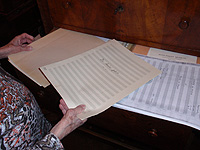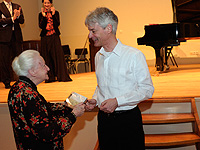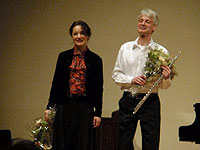


An, until recently, unknown work of the composer F. Martin (1980-1974) came to light in the summer of 2008. The composer, who was born in Swicherland and was married three times, spend the last 28 years of his life in Holland: He first stayed in Amsterdam (1946-1956) and then moved to Naarden (1956-1974), a province near Amsterdam, where his widow Maria Martin – Boeke still resides. Their home in Naarden – named Frank Martin House since 1996 – is open to those interested in the composers work.
In that house Maria Martin discovered a work of her husband she had not seen before in an old chest drawer. She immediately contacted Rien de Reede, who is a member of the Council of the Frank Martin Foundation, to inform him of her discovery. Deuxième Ballade pour flûte et piano ou flûte, orchestre à corde, piano et batterie[1], d’après la Ballade pour saxophone alto, orchestre à corde, piano et batterie. On the cover of the manuscript one can read the date 1938 which is the year the composer also wrote the Ballad for saxophone. This is rather significant as Martin’s Ballad for flute and piano, composed in 1939, seems to have been written after the newly discovered piece, which is nonetheless entitled Deuxième Ballade.[2]
Having witnessed the performance of this piece by the Dutch flutist Thies Roorda and the Georgian pianist Nata Tsvereli in Amsterdam, I met with Thies in his home in Vossiusstraat that overlooks the wonderful Vondenpark and discussed with him.
K.A. First I would like to congratulate you on the release of your new CD, which includes the newly discovered Ballad, as well as your performance in Bethaniënklooster in Amsterdam a few days ago which was excellent. I would like to begin by asking how you came across Frank Martin’s Deuxième Ballade ?
T.R. Well, that’s something M. Martin should answer but, as far as I know, she did not know it existed. She was surprised because there is no trace in any publication nor letter that Mme Martin knows of where the composer mentions its existence. That was also the reason why the Martin Foundation said: “let’s first listen to it”, because it may not be any good and the composer might have had his reasons not to use it. The pianist Nata Tsvereli and I presented it to the Frank Martin Foundation. That was the unofficial première, it was for 20-30 people among them Maria Martin, Rien de Reede[3] και Emily Beynon.[4] After that we played it at the ceremony of the opening of the school year 2009-2010 at the Royal Conservatory of the Hague in Schönberg Zaal on Monday 31 August. That was for the students and the colleagues, and after that we played it on 6 February 2010 in Bethaniënklooster, Amsterdam. By then we also presented the CD recording [5] and it was handed over to Mme Martin.
K.A. Let’s now discuss the date of this transcription. The composer noted the year 1938 on the manuscript. Is that the year the work was actually composed and what problems arise concerning its chronology?
T.R. Given the fact that the composer explicitly states that this piece is for flute and piano and also given the fact that the rehearsal numbers on the score are exactly as the rehearsal numbers in the saxophone or bass-clarinet piano score, Hans Maas [6] assumed that F. Martin wrote the Deuxième Ballade at a moment when the piano reduction was already there. This seems to make sense but now we know that this score came on sometime later.[7]
So the Deuxième Ballade would have to have been composed several years later than 1938, the date that is noted on the manuscript. Maria Martin however does not agree with this point of view.[8] When the composer initially composed this work he didn’t compose immediately the piano reduction, which seems to have been done later by an English musician John Lenehan. I initially didn’t know this. We I started playing from a part and I heard the pianist at our first rehearsal doing very different things. My version was a book, which had this first edition and I had taken from the library of the Royal Conservatory of the Hague.[9]
Finally it turned out that Lenehan had reduced the orchestral part dramatically. So, that;s why the saxophone piece is called Ballade pour saxophone alto, orchestre à corde, piano et batterie and the flute piece is called Deuxième Ballade pour flûte et piano ou flûte, orchestre à corde, piano et batterie. The compositional porcedure is different.
K.A. Indeed..., Well, Emmanul Pahud is preparing the First Performance of the other version of this Ballade, isn’t he ?
T.R. Yes, after the presentation of the Deuxième Ballade in the F. Martin Foundation, one or two weeks later, Pahud came to visit us (or rather he was here with the orchestra and so he came over) and Rien told him: “You should listen to this piece because it is a piece you don’t know”. Pahud responded: “Wow! I want to play it”, and he was immediately making arrangements for a recording with the orchestra.
K.A. Do we know why Martin did this transcription?
T.R. Not really, but it is a fact that the original Ballad for Saxophone is very difficult, because it is higher in register than most saxophonists feel confident to play. It was composed for the saxophonist Sigurt Racher who happened to be very good on high notes. So the fact that this piece was custom made for the particular player seems to be reason why it is so uncomfortable for other saxophonists to play, as I am told.
Furthermore, flutists are more active than saxophone players, because as you know the flute world has a dynamic of its own, and moreover as the First Ballad of Martin for flute is played almost everywhere (unlike the one for saxophone) maybe Martin arranged it for flute to make it more accessible to the public. It is actually twice as long as the first Ballad and it is not written to impress but to express…I think that the difference is generated by the purpose. The purpose of the first ballade was a competition, and it happened to be a very good piece of music. The purpose of the other ballad was just a concert for a solo instrument with orchestra.
[1] cymbales, grosse caisse et caisse claire [cymbals, bass drum and snare drum].
[2] Frank Martin, Deuxième Ballade pour flute et piano, Universal Edition A.G., Wien, 2009(UE 34 699).
[3] Rien de Reede is a member of the Council of The Frank Martin Fountation. He was a flutist in Concertgebouworkest for about 30 years (until 2003) and as a renowned musician he is a member of various comities in international competitions for winds instruments.
[4] Emily Beynon is a renowned flutists and flute teacher. She was the first non Dutch female flutist to join the Concertgebouworkest orchestra as a principal flutist at the age of 25.
[5] CD premier of the Deuxième Ballade on Saturday the 29th of August, see Beyond Late Romanticism, Thies Roorda, (flute), Nata Tsvereli (piano), DRC 101009/01.
[6] Maas, H., “Frank Martin – Deuxième Ballade”, Fluit (2010-1), 9-12; Hans Maas is a musicologist and part of the editorial committee of the Dutch magazine Fluit.
[7] The exact date for the piano part is unknown. Mme Martin discovered it after the composer’s death and the manuscript does not include information about when it was composed.
[8] Maria Martin states that the piece was composed right after the Ballade for Piano and Orchestra (December 1939). In other words she believes that the newly discovered Ballad was composed in the end of 1939 and the first month of 1940, before Frank Martin was commissioned to compose Ballade for Trombone and Orchestra. The first Ballade for Flute and Piano was finished and had already been presented at the Concours International d’ exécution musicale de Genève in the fall of 1939. This is why the newly discovered work is entitled Deuxieme.
[9] The first edition of the Ballad for saxophone included Lenehan’s piano reduction.
Photos by Konstantinos Andreou and Piet Roorda


